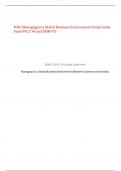lOMoARcPSD|43502630
WGU Managing in a Global Business Environment Study Guide
Final FVC1 V4 and D080 V3
D080.V3-FVC1 V4 Study Guide final
Managing in a Global Business Environment (Western Governors University)
, lOMoARcPSD|43502630
Managing in a Global Business Environment
Study Guide for FVC1 V4 and D080 V3
Unit 2 Globalization
Module 1: Political, Economic, and Legal Systems
1. What is globalization?
is when international integration arises from the interchange of world
views, products, ideas, and other aspects of culture.
2. What opportunities to businesses are brought by globalization?
globalization has allowed corporations to outsource manufacturing and
service jobs from high- cost locations to lower cost locations, where
corporations can pay workers lower salaries and provide fewer (or no)
benefits.
3. What are the economic, political, and cultural effects of globalization?
Elaborate on each of the aspect.
a) Cultural: Cultural globalization refers to the transmission of
ideas, meanings, and values around the world in such a way
that extends and intensifies social relations.
b) Political: In general, globalization may ultimately reduce the
importance of nation- states. Supranational institutions, such as
the European Union, the World Trade Organization (WTO), the
Group of Eight (G8), and the International Criminal Court, serve
to replace or extend national functions to facilitate
international agreement.
c) Economic globalization refers to the widespread, international
movement of goods, capital, services, technology, and
information. It is the increasing economic integration and
, lOMoARcPSD|43502630
interdependence of national, regional, and local economies across
the world through an intensification of the cross-border
movement of goods, services, technologies, and capital.
4. What are the arguments for and against globalization from country’s
perspective? Globalization has resulted in a widespread sharing of ideas.
Advocates for globalization feel that this sharing exposes people to more
cultures and ideas, making them more tolerant. Opponents to
globalization worry that cultures are becoming homogenized, especially in
the spread of Western culture throughout the world.
5. What are the 5 stages of entering a global market? Explain each stage.
a) In the first stage (market entry), companies enter new countries
using business models similar to the ones deployed in their home
markets. To gain access to local customers, however, companies
often need to establish a production presence, either because of
the nature of their businesses, such as in-service industries like
food, retail, or banking, or because of local countries' regulatory
restrictions, such as in the auto industry.
b) In the second stage (product specialization), companies transfer
the full production process of a particular product to a single,
low-cost location and export the goods to various consumer
markets. In this scenario, different locations begin to specialize in
different products or components and trade in finished goods.
c) The third stage (value chain disaggregation) represents the next
step in the company's globalization of the supply chain
infrastructure. In this stage, companies disaggregate the
production process and focus on completing each activity in the
most advantageous location. Individual components of a single
product might be manufactured in several different places and
assembled into final products elsewhere. Examples include the PC
industry market and the decision by companies to offshore some
of their business processes and information technology services.2
, lOMoARcPSD|43502630
d) In the fourth stage (value chain reengineering), companies seek
to further increase their cost savings by reengineering their
processes to suit local market conditions by substituting lower
cost labor for capital. General Electric's (GE) medical equipment
division, for example, has tailored its manufacturing processes
abroad to take advantage of low labor costs. Not only does it use
more labor-intensive production processes, but it also designs
and builds the capital equipment for its local plants.2
e) Finally, in the fifth stage (creation of new markets), the focus is on
market expansion. This allows companies to substantially lower
their sticker prices in both old and new markets and to expand
demand. Significantly, the value of new revenues generated in this
last stage is often greater than the value of cost savings in the
other stages.
6. What are the benefits and costs of global expansion from MNCs’
perspective? benefits of expanding into developing markets include
unsaturated demand for new products, lower labor costs, less expensive
natural resources, and other inputs to products. seek to benefit from
globalism by selling goods in multiple countries as well as by sourcing
production in areas that can produce goods more profitably.
Cost: look for opportunities to realize economies of scale by mass-
producing goods in markets that have substantially cheaper costs for labor
or other inputs, or they may look for economies of scope.
7. What are the 4 drivers of globalization? Explain.
a) Market Drivers: One aspect of globalization is the steady
convergence of customer needs. As customers in different parts of




